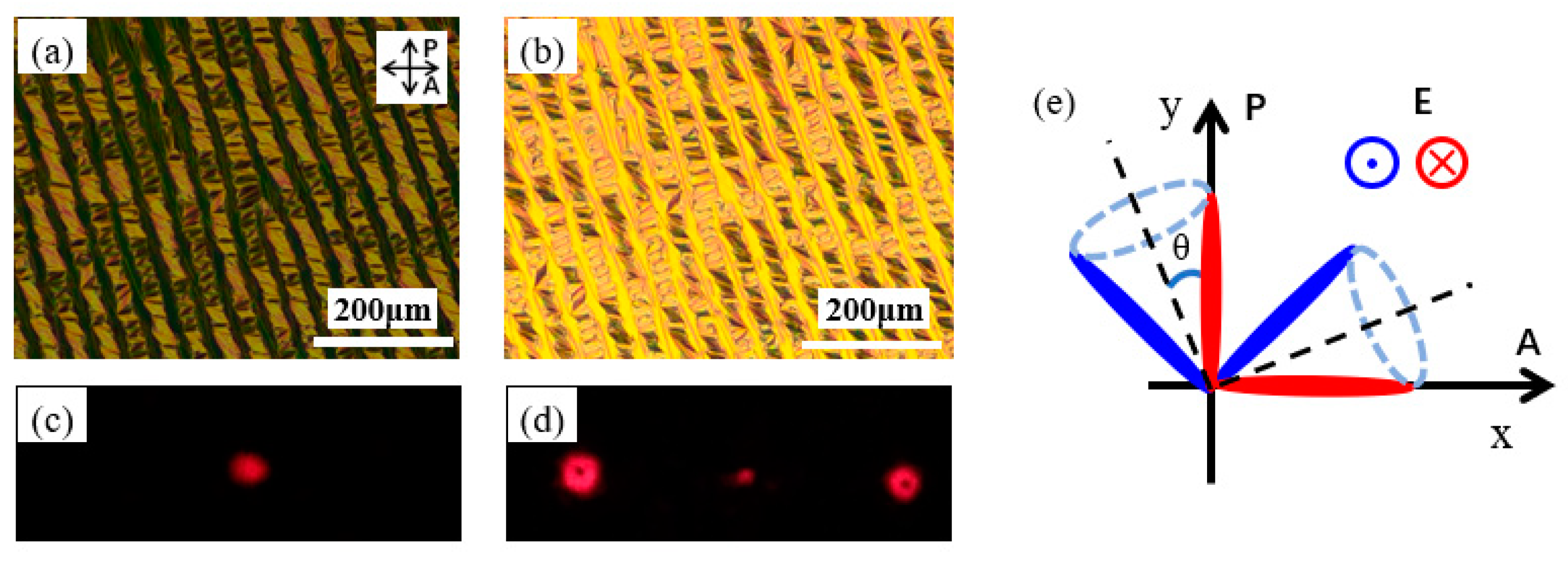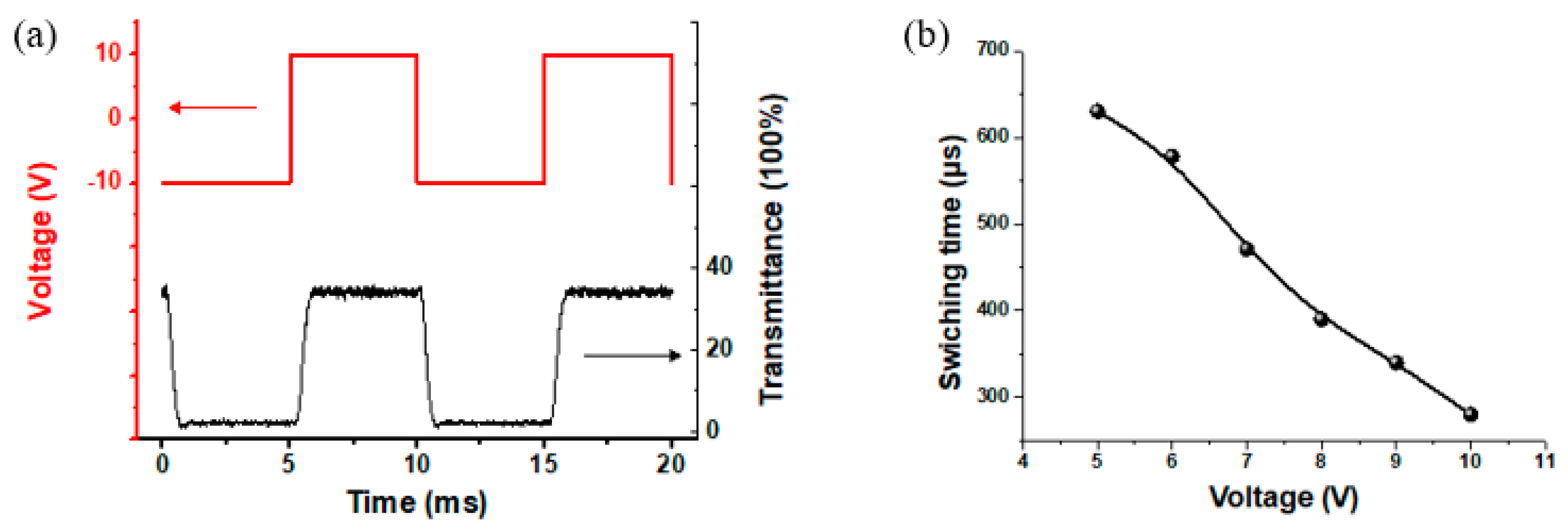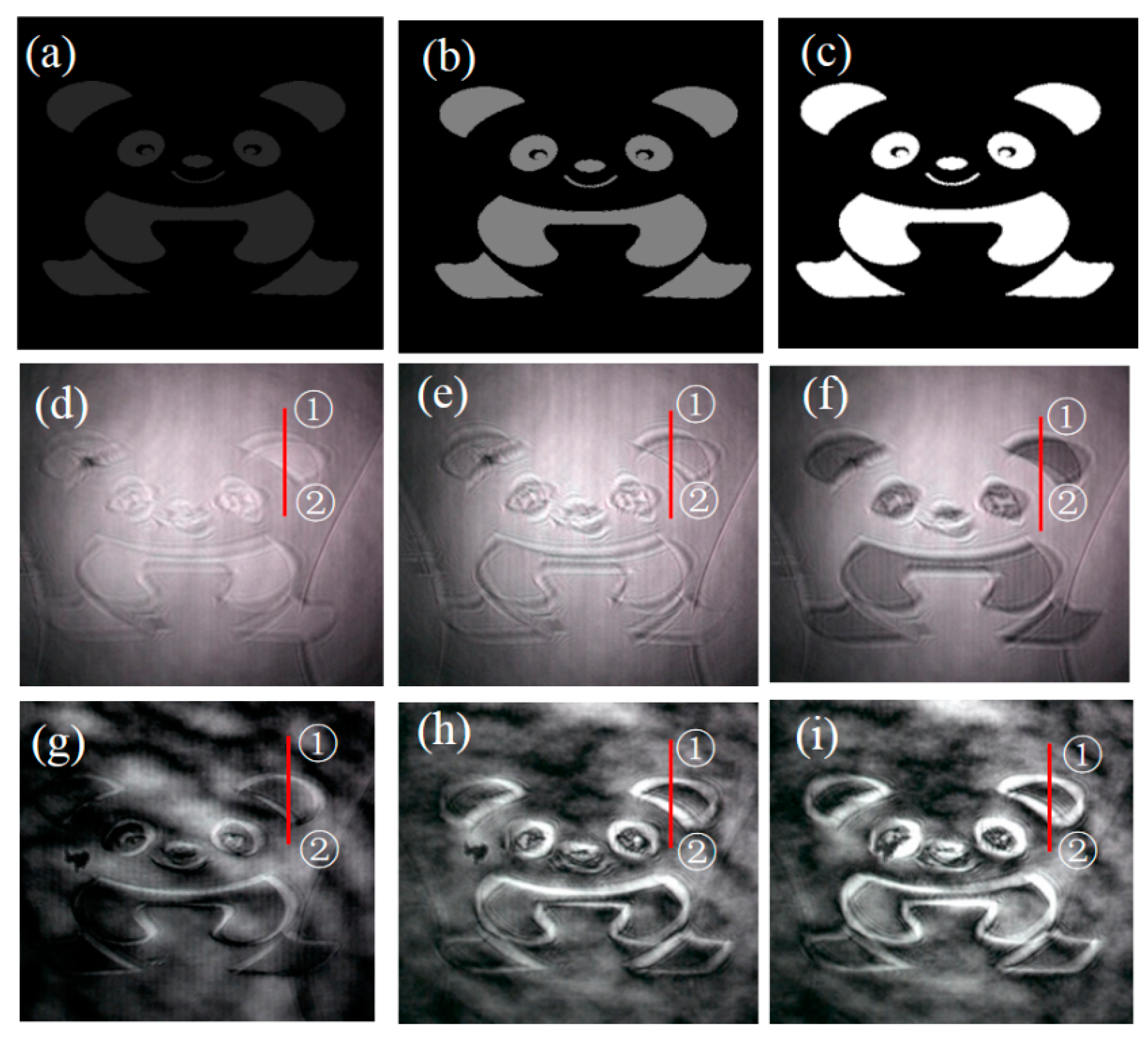Photo-Aligned Ferroelectric Liquid Crystal Fork Grating-Mediated Fast Switchable Spiral Phase Contrast Imaging
Abstract
1. Introduction
2. Material and Methods
3. Results and Discussion
4. Conclusions
Author Contributions
Funding
Institutional Review Board Statement
Informed Consent Statement
Data Availability Statement
Conflicts of Interest
References
- He, H.; Friese, M.E.; Heckenberg, N.R.; Rubinsztein-Dunlop, H. Direct observation of transfer of angular momentum to absorptive particles from a laser beam with a phase singularity. Phys. Rev. Lett. 1995, 75, 826–829. [Google Scholar] [CrossRef] [PubMed]
- Grier, D.G. A revolution in optical manipulation. Nature 2003, 424, 810–816. [Google Scholar] [CrossRef]
- Willner, A.E.; Huang, H.; Yan, Y.; Ren, Y.; Ahmed, N.; Xie, G.; Bao, C.; Li, L.; Cao, Y.; Zhao, Z.; et al. Optical communications using orbital angular momentum beams. Adv. Opt. Photon. 2015, 7, 66–106. [Google Scholar] [CrossRef]
- Wang, J.; Yang, J.Y.; Fazal, I.M.; Ahmed, N.; Yan, Y.; Huang, H.; Ren, Y.; Yue, Y.; Dolinar, S.; Tur, M.; et al. Terabit free-space data transmission employing orbital angular momentum multiplexing. Nat. Photon. 2012, 6, 488–496. [Google Scholar] [CrossRef]
- Toyoda, K.; Takahashi, F.; Takizawa, S.; Tokizane, Y.; Miyamoto, K.; Morita, R.; Omatsu, T. Transfer of light helicity to nanostructures. Phys. Rev. Lett. 2013, 110, 143603. [Google Scholar] [CrossRef]
- Ni, J.; Wang, C.; Zhang, C.; Hu, Y.; Yang, L.; Lao, Z.; Xu, B.; Li, J.; Wu, D.; Chu, J. Three-dimensional chiral microstructures fabricated by structured optical vortices in isotropic material. Light Sci. Appl. 2017, 6, e17011. [Google Scholar] [CrossRef] [PubMed]
- Situ, G.; Warber, M.; Pedrini, G.; Osten, W. Phase contrast enhancement in microscopy using spiral phase filtering. Opt. Commun. 2010, 283, 1273–1277. [Google Scholar] [CrossRef]
- Serabyn, E.; Mawet, D.; Burruss, R. An image of an exoplanet separated by two diffraction beamwidths from a star. Nature 2010, 464, 1018–1020. [Google Scholar] [CrossRef]
- Qiu, X.; Li, F.; Zhang, W.; Zhu, Z.; Chen, L. Spiral phase contrast imaging in nonlinear optics: Seeing phase objects using invisible illumination. Optica 2018, 5, 208–212. [Google Scholar] [CrossRef]
- Jesacher, A.; Furhapter, S.; Bernet, S.; Ritsch-Marte, M. Shadow effects in spiral phase contrast microscopy. Phys. Rev. Lett. 2005, 94, 233902. [Google Scholar] [CrossRef]
- Furhapter, S.; Jesacher, A.; Bernet, S.; Ritsch-Marte, M. Spiral phase contrast imaging in microscopy. Opt. Express 2005, 13, 689–694. [Google Scholar] [CrossRef] [PubMed]
- Sharma, M.K.; Joseph, J.; Senthilkumaran, P. Directional edge enhancement using superposed vortex filter. Opt. Laser Technol. 2014, 57, 230–235. [Google Scholar] [CrossRef]
- Wang, J.; Zhang, W.; Qi, Q.; Zheng, S.; Chen, L. Gradual edge enhancement in spiral phase contrast imaging with fractional vortex filters. Sci. Rep. 2015, 5, 15826. [Google Scholar] [CrossRef]
- Bernet, S.; Jesacher, A.; Furhapter, S.; Maurer, C.; Ritsch-Marte, M. Quantitative imaging of complex samples by spiral phase contrast microscopy. Opt. Express 2006, 14, 3792–3805. [Google Scholar] [CrossRef] [PubMed]
- Guo, C.S.; Han, Y.J.; Xu, J.B.; Ding, J.P. Radial Hilbert transform with Laguerre-Gaussian spatial filters. Opt. Lett. 2006, 31, 1394–1396. [Google Scholar] [CrossRef] [PubMed]
- Huo, P.; Zhang, C.; Zhu, W.; Liu, M.; Zhang, S.; Zhang, S.; Chen, L.; Lezec, H.J.; Agrawal, A.; Lu, Y.; et al. Photonic Spin-Multiplexing Metasurface for Switchable Spiral Phase Contrast Imaging. Nano Lett. 2020, 20, 2791–2798. [Google Scholar] [CrossRef] [PubMed]
- Zheng, C.; Liu, J.; Li, H.; Wang, M.; Zang, H.; Zhang, Y.; Yao, J. Terahertz metasurface polarization detection employing vortex pattern recognition. Photonics Res. 2023, 11, 2256–2263. [Google Scholar] [CrossRef]
- Zheng, C.; Li, H.; Zang, H.; Yao, J. Terahertz polarization detection based on the mode analysis of longitudinally polarized vortices. Opt. Laser Technol. 2024, 170, 110210. [Google Scholar] [CrossRef]
- Sun, J.; Liu, Y.; Liu, H.; Gong, X.; Chigrinov, V.G. Increasing rewriting speed of optically driving liquid crystal display by process optimization. Liq. Cryst. 2018, 46, 151–157. [Google Scholar] [CrossRef]
- Ma, Y.; Sun, J.; Srivastava, A.K.; Guo, Q.; Chigrinov, V.G.; Kwok, H.S. Optically rewritable ferroelectric liquid-crystal grating. Europhys. Lett. 2013, 102, 24005. [Google Scholar] [CrossRef]
- Wei, B.Y.; Hu, W.; Ming, Y.; Xu, F.; Rubin, S.; Wang, J.G.; Chigrinov, V.; Lu, Y.Q. Generating switchable and reconfigurable optical vortices via photopatterning of liquid crystals. Adv. Mater. 2014, 26, 1590–1595. [Google Scholar] [CrossRef] [PubMed]
- Ma, Y.; Wei, B.Y.; Shi, L.Y.; Srivastava, A.K.; Chigrinov, V.G.; Kwok, H.S.; Hu, W.; Lu, Y.Q. Fork gratings based on ferroelectric liquid crystals. Opt. Express 2016, 24, 5822–5828. [Google Scholar] [CrossRef] [PubMed]
- Chigrinov, V.; Panarin, Y.; Vorflusev, V.; Pozhidaev, E. Aligning properties and anchoring strength of Ferroelectric Liquid Crystals. Ferroelectrics 1996, 178, 145–154. [Google Scholar] [CrossRef]
- Guo, Q.; Srivastava, A.K.; Pozhidaev, E.P.; Chigrinov, V.G.; Kwok, H.S. Optimization of alignment quality of ferroelectric liquid crystals by controlling anchoring energy. Appl. Phys. Express 2014, 7, 021701. [Google Scholar] [CrossRef]
- Guo, Q.; Srivastava, A.K.; Chigrinov, V.G.; Kwok, H.S. Polymer and azo-dye composite: A photo-alignment layer for liquid crystals. Liq. Cryst. 2014, 41, 1465–1472. [Google Scholar] [CrossRef]
- Moreno, I.; Davis, J.A.; Pascoguin, B.M.; Mitry, M.J.; Cottrell, D.M. Vortex sensing diffraction gratings. Opt. Lett. 2009, 19, 2927–2929. [Google Scholar] [CrossRef]
- Reynolds, G.O.; DeVelis, J.B.; Parrent, G.B., Jr.; Thompson, B.J. The New Physical Optics Notebook: Tutorials in Fourier Optics; SPIE Optical Engineering Press: Bellingham, WA, USA, 1989. [Google Scholar]
- Davis, J.A.; McNamara, D.E.; Cottrell, D.M.; Campos, J. Image processing with the radial Hilbert transform: Theory and experiments. Opt. Lett. 2000, 25, 99–101. [Google Scholar] [CrossRef]
- Bouchal, P.; Bouchal, Z. Selective edge enhancement in three-dimensional vortex imaging with incoherent light. Opt. Lett. 2012, 37, 2949–2951. [Google Scholar] [CrossRef]







| Phase Step | π/3 | 2π/3 | π |
|---|---|---|---|
| ① in bright field image | 6.3% | 30.5% | 50.0% |
| ② in bright field image | 16.7% | 18.4% | 37.9% |
| ① in edge-enhanced image | 33.2% | 66.8% | 82.4% |
| ② in edge-enhanced image | 32.8% | 87.1% | 94.5% |
Disclaimer/Publisher’s Note: The statements, opinions and data contained in all publications are solely those of the individual author(s) and contributor(s) and not of MDPI and/or the editor(s). MDPI and/or the editor(s) disclaim responsibility for any injury to people or property resulting from any ideas, methods, instructions or products referred to in the content. |
© 2024 by the authors. Licensee MDPI, Basel, Switzerland. This article is an open access article distributed under the terms and conditions of the Creative Commons Attribution (CC BY) license (https://creativecommons.org/licenses/by/4.0/).
Share and Cite
Guo, Q.; Zhong, Z.; Zhao, H.; Wang, S.; Yan, K. Photo-Aligned Ferroelectric Liquid Crystal Fork Grating-Mediated Fast Switchable Spiral Phase Contrast Imaging. Photonics 2024, 11, 85. https://doi.org/10.3390/photonics11010085
Guo Q, Zhong Z, Zhao H, Wang S, Yan K. Photo-Aligned Ferroelectric Liquid Crystal Fork Grating-Mediated Fast Switchable Spiral Phase Contrast Imaging. Photonics. 2024; 11(1):85. https://doi.org/10.3390/photonics11010085
Chicago/Turabian StyleGuo, Qi, Zidi Zhong, Huijie Zhao, Shijie Wang, and Kexin Yan. 2024. "Photo-Aligned Ferroelectric Liquid Crystal Fork Grating-Mediated Fast Switchable Spiral Phase Contrast Imaging" Photonics 11, no. 1: 85. https://doi.org/10.3390/photonics11010085
APA StyleGuo, Q., Zhong, Z., Zhao, H., Wang, S., & Yan, K. (2024). Photo-Aligned Ferroelectric Liquid Crystal Fork Grating-Mediated Fast Switchable Spiral Phase Contrast Imaging. Photonics, 11(1), 85. https://doi.org/10.3390/photonics11010085






